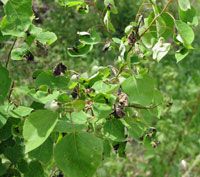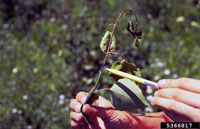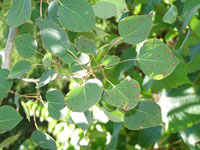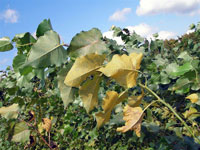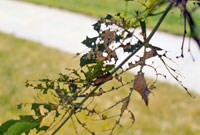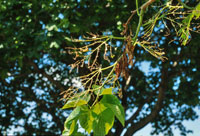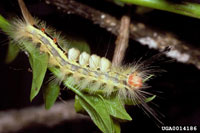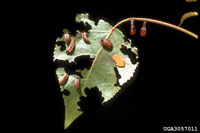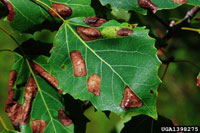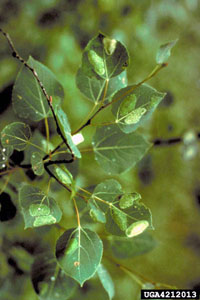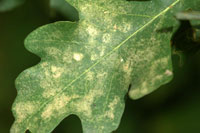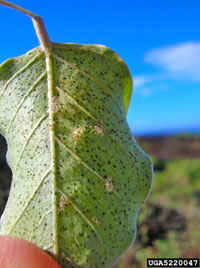Extension > Garden > Diagnose a problem > What's wrong with my plant? > Deciduous Trees > Poplar > Dots, spots or blotches on leaves
Poplar > Leaves > Dots, spots or blotches on leaves
1 of 7
Venturia shoot blight (Scab)
Venturia spp.
- Affected areas leaves and petioles turn black
- Infected shoots droop, wither resembling a Shepard's crook
- Leaves become brittle and fall off
- More information on Venturia shoot blight
2 of 7
Leaf spot and canker blights
Marssonina spp., Septoria spp., Colletotrichum
gloeosporioides
- Irregular dark spots (angular to round) to large blotches on leaf surface
- Severe infestations may lead to leaf yellowing full defoliation by late summer
- Lower branches are infected first
- Dark, sunken cankers can develop on stems of Septoria infected
- More information on Leaf spot and canker blights
3 of 7
Poplar rust
Melampsora medusae
- Yellow to orange spore pustules on leaf underside, yellow spots on leaf surface
- Powdery orange to yellow spores can be seen if lower leaf surface is rubbed with a white cloth
- Severely infected leaves dry, shrivel and fall prematurely
- Lower branches are first infected
- In severe infestations, trees can loose all leaves within a few weeks
- More information on Poplar rust
4 of 7
Whitemarked tussock moth
Orygia leucostigma
- Young larvae windowpane feed (i.e. feed on one layer of leaf tissue between veins) giving them a lacelike
- Older larvae consume entire leaves except the midrib and large veins
- Caterpillars have a red-orange head with two sets of black tufts near the head; yellowish hairy body with distinct tufts of hair resembling a toothbrush on top of the body
- Full grown larvae are 1 ¼ inches long
- Damage by 2 generations, first from May to June and a second one from August to September
- More information on Whitemarked tussock moth
5 of 7
Cottonwood leaf beetle
Chrysomela scripta
- Larvae windowpane feed, i.e. feed on the upper leaf surface between the veins
- Adults eat leaf margins and create "shot-holes" in leaf tissue
- Defoliation can occur when populations are high
- Adults are ¼ inch long with yellow and black stripes
- Larvae are black when young and have 2 white dots on either side
6 of 7
Aspen blotch miner
Phyllonorycter tremuloidiella
- Mines are whitish or opaque at first but eventually turn
- Larvae feed between leaf surfaces create blotch-like mines
- Common in late summer
7 of 7
Poplar lace bug
Corythucha elegans
- White or yellow speckled or pinprick discolorations on upper leaf
- Can look bleached when infestations are more severe
- Lace bugs are up to 1/4 inch long; light colored bodies with dark colored spots; intricate, lacy wings
- More information on Poplar lace bug




